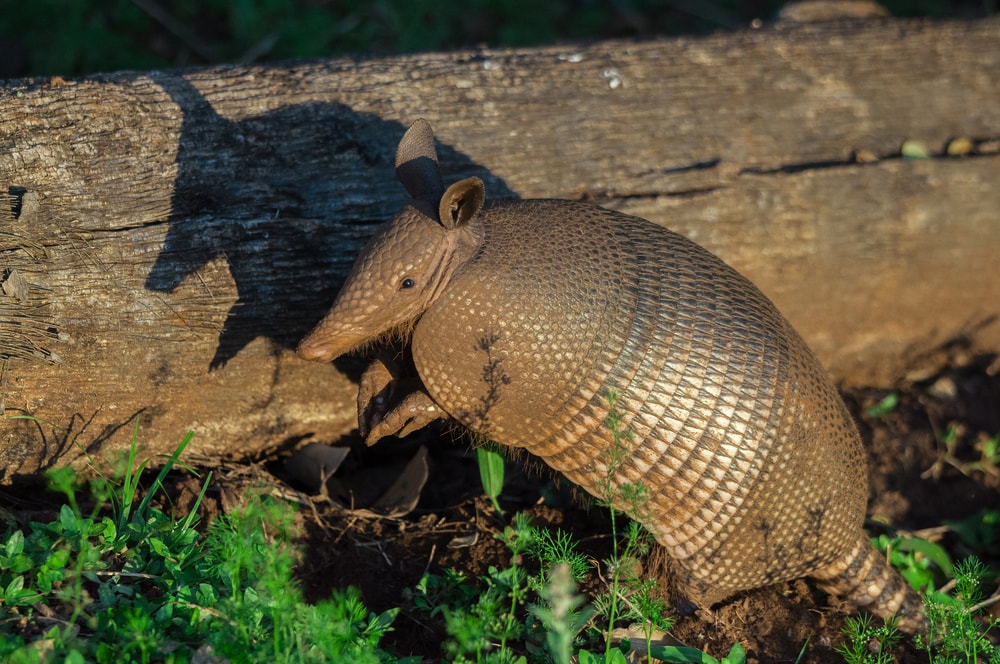If you’ve ever taken a road trip through the southern half of the United States, you’ve likely seen an armadillo meandering down the side of the road. Do you know much about them though?

Of the 20 different types of armadillos roaming North and South America, only one calls the U.S. home: the nine-banded armadillo. The name is a little misleading, as nine-banded armadillos can have anywhere from seven to 11 bands on its hard shell.
Armadillos have terrible eyesight but an excellent sense of smell, as well as strong legs and sharp claws. These peaceful mammals, typically no bigger than the size of a small dog, use their powerful noses to forage for food at night. Like raccoons and skunks, armadillos are helpful wildlife creatures, depending on where they make their home.
Where do armadillos live?
Armadillos enjoy warm, wet environments, which is why they stick mostly to the southern states. Most enjoy forests and grasslands, and because they can hold their breath for six minutes, they have no problem crossing a river or a stream. You can even see one walking along the bottom of a clear stream.
Armadillos burrow underground to sleep for up to 16 hours. They often have multiple burrows situated around their hunting grounds, but they aren’t territorial and have no problem leaving to find better feeding grounds. Their abandoned abodes often end up hosting other burrowing animals, like snakes, skunks and rats.
What do armadillos eat?
The nocturnal armadillo ventures out of its underground home to hunt for food in the early evenings after dusk. The bulk of their diet consists of insects like termites, beetles, grubs, cockroaches and scorpions, just to name a few. They’re also known to eat small reptiles and amphibians and their eggs in colder weather. A little bit of plant matter finds its way into the armadillo's diet, as well.
Are armadillos aggressive?
The short answer is no. It is important to keep in mind, however, that armadillos are wild animals and can possibly communicate diseases like leprosy and rabies if handled or eaten. (Yes, some people are a big fan of ‘dillo meat.)
But unless you try to catch one, it’s unlikely an armadillo will pay you any mind if you see one waddling by. Although catching one proves harder than you might expect — armadillos are surprisingly fast.
Fun facts about armadillos
- Armadillos live anywhere from seven to 20 years.
- They give birth once a year, and always to a litter of four males or four females.
- Despite popular belief, only two types of armadillos can roll themselves into a ball: the Brazilian armadillo and the southern three-banded armadillo. Both are found in South America.
- Armadillos are the only living mammal with a hard shell.
- Northwestern University has celebrated its annual Dillo Day since 1972.
Is an armadillo the culprit ruining your yard?
If you suspect an armadillo has chosen your yard as its new favorite foraging ground, look for these clues:
- Holes in your yard anywhere from 3 to 5 inches wide and 1 to 3 inches deep
- Burrow entrances near your porch, shed or low-lying shrubs
- Cracked sidewalks and/or driveway
- Tracks with four toes in the front and five toes in the back
Should you trap an armadillo yourself?
Again, the answer here is no. While you don’t want armadillos tearing up your lawn, they do provide a great service by eating undesirable insects. And remember: As wild animals, they could be carrying some harmful diseases.
A professional can more accurately pinpoint the critter causing damage to your property and knows how to set the appropriate traps at the best spots. A pest control professional can identify what's attracting the armadillos in the first place and help pest-proof your home and yard in case any other creatures are looking for some new burrows to set up shop in.



